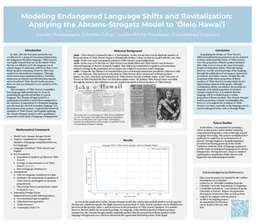Like
Be the first to like this
Last week the trainings and discussions we had cut across the disciplines. How does the interdisciplinary nature of this program, the fact that students are focusing on such a diverse range of projects, help you think about your project and/or your academic interests more broadly?
- For a long time, I have struggled to classify myself as purely a STEM person or a humanities person. However, through the interdisciplinary nature of this program, I have come to realize that STEM and humanities fields overlap in many ways, and are not mutually exclusive. My project bridges many of my own interdisciplinary interests, including mathematics and linguistics. Though these two fields may initially seem unrelated, working on my project has emphasized how connected the two fields truly are. In understanding the indigenous Hawaiian language, 'Ōlelo Hawai'i, ethnographic and linguistic research is necessary, but providing a quantitative perspective through math modeling adds an additional dimension to the research I am doing.
As you begin your individual research projects this week, do you anticipate any challenges in getting started? If so, what are they?
- For the final output of my project, I am writing a research paper that compiles my mathematical analysis of the indigenous Hawaiian language while also incorporating the linguistic and ethnographic research I am completing. Due to the high volume of research I have already compiled, one challenge I have been facing is in cutting down the material and narrowing the scope of my paper. Organizing such a high quantity of research and material has been difficult so far, but as I do have significant time ahead of me, I am hoping this will not prove to be too limiting.


Please sign in
If you are a registered user on Laidlaw Scholars Network, please sign in
Hi Aneesha! Your reflection really resonated with me, especially your point about moving beyond the binary of STEM vs. Humanities. I think it’s so powerful that you’re integrating mathematical modeling with linguistic and ethnographic research on ‘Ōlelo Hawai‘i. This kind of interdisciplinary synthesis not only adds depth to your work, but also challenges conventional academic boundaries.
I'm curious—how has incorporating a quantitative framework shaped or possibly even changed the way you interpret cultural or linguistic insights from your ethnographic research? Has it ever complicated or enhanced your understanding in unexpected ways?